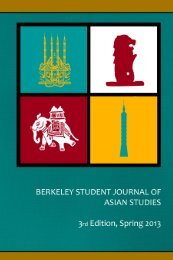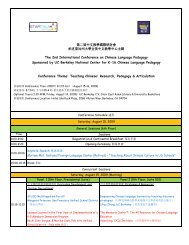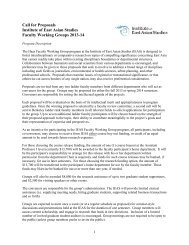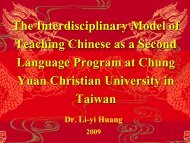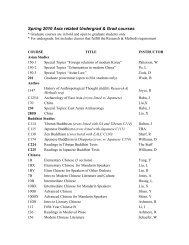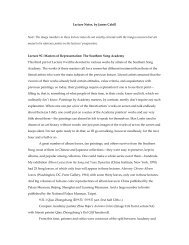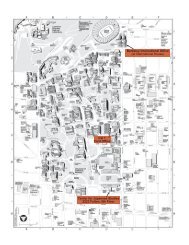short essay - Institute of East Asian Studies, UC Berkeley
short essay - Institute of East Asian Studies, UC Berkeley
short essay - Institute of East Asian Studies, UC Berkeley
- No tags were found...
You also want an ePaper? Increase the reach of your titles
YUMPU automatically turns print PDFs into web optimized ePapers that Google loves.
the protestant imagination (barshay) 8modernization, and therefore its modernity, was tragically incomplete, and as such,deformed.Bellah’s response to Maruyama’s review was open-handed and accepting, to a point. In away, he never stopped responding to it. By the early 1960s he had been able to travel toJapan and make up for lost time in examining contemporary Japanese religion andintellectual life. I would say, in fact, that the latter was his real concern, to judge by theseries <strong>of</strong> finely wrought and ambitious <strong>essay</strong>s on Ienaga Saburō, Watsuji Tetsurō, and thegeneral question <strong>of</strong> intellectual and society in Japan that he produced over the succeedingdecade. He acknowledged that Maruyama’s critique had struck to the core <strong>of</strong> hisargument, while also confirming his view <strong>of</strong> the special significance <strong>of</strong> Protestantism. “IfMaruyama is right, and I am coming increasingly to believe that he is, then it becomesnecessary to press beyond motivational and institutional approaches and to view mattersin an even broader perspective…The Protestant Reformation is not after all some merespecial case <strong>of</strong> a more general category. It stands…as the symbolic representative <strong>of</strong> afundamental change in social and cultural structure with the most radical and farreachingconsequences. The proper analogy in Asia then turns out to be, not this or thatmotivational or institutional component, but reformation itself.” Bellah went on to pointout (drawing on Uchimura Kanzō) that the “failure <strong>of</strong> structural transformation” hadauthored disaster in Germany and transferred the mantle <strong>of</strong> reformation to England—and America, where he clearly believed it had remained. 16For some time, Reformation was the pivotal orientation in Bellah’s thought, and he wrote,as Maruyama never could, from within it, not just in a scholarly sense but religiously aswell. There is an almost proprietary feeling in his writings on this theme, as for examplewhen he describes the “tradition <strong>of</strong> submerged transcendence” in Japan that had to wagea constant, even Sisyphean struggle against the still strongly salient value pattern in whichthe individual remains embedded in, even indistinct from the social nexus. He also usedthe metaphor <strong>of</strong> the “ground bass” to characterize that value pattern; in any case, theimage <strong>of</strong> the Reformed society-that-ought-to-be informs almost everything Bellah wroteabout Japan. 17It is interesting, and perhaps a little counterintuitive, that it took an immersion in hisown society, rather than the study <strong>of</strong> an alien one, to dislodge that image. In the late1960s, Bellah’s long-running concern with religious evolution, with its focus on the“axial” breakthroughs <strong>of</strong> the first millennium BCE, and a fortuitous but powerfulintervention on “civil religion” in the United States combined to put an end (for the mostpart) to his active study <strong>of</strong> Japan. Perhaps his last important contribution was a 1978<strong>essay</strong> contrasting what he called Ogyū Sorai’s “conceptual consciousness”—abstract,distinction-making, instrumentalist, even manipulative—to the experiential, connectionmaking,ego-denying “symbolic consciousness” that he saw at work in Ishida Baigan’s16 Robert N. Bellah, “Reflections on the Protestant Ethic Analogy in Asia” (1962), in id., BeyondBelief: Essays on Religion in a Post-Traditional World (Harper & Row, 1976), pp. 53-63, esp. pp. 57-58.17 See for example, “Continuity and Change in Japanese Society” (1971) in id., Imagining Japan:The Japanese Tradition and its Modern Interpretation (University <strong>of</strong> California Press, 2003), pp. 184-208;“Values and Social Change in Modern Japan” (1961) in Beyond Belief, pp. 118-45.




